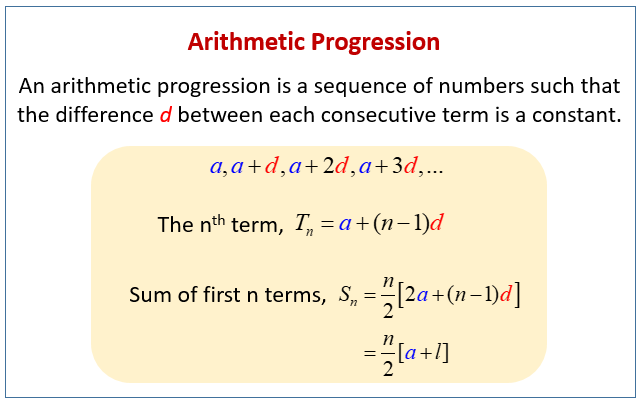Arithmetic Progression Examples With Solutions
Video of all questions are also available. Ad Find the right instructor for you.

Sum Of The First N Terms Of An Arithmetic Progression A Plus Topper
By an arithmetic progression of terms we mean a finite sequence of the form.

. What is an Arithmetic Progression. For example from 4 to 9 you add 5 to 4 to get to 9. Choose from many topics skill levels and languages.
The property of this sequence is that the difference between. An arithmetic sequence is a list of numbers with a definite patternIf you take any number in the sequence then subtract it by the previous one and the result is always the same or constant then it is an arithmetic sequence. Such as 1 4 7 10 13 16.
Finding n th term of an AP a n Finding n using a n formula. In this post well learn about the definition formula and examples for the arithmetic sequence. Find the sum of the first 18 terms.
Using the formula detailed above we can solve various arithmetic sequence examples. Find the value of y so that the sequence becomes an Arithmetic progression. If displaystyle a_14 a1 4 and displaystyle a_27 a2 7 determine displaystyle a_ 11 a11.
Please go through the below link for basic concepts of Sequence and series fundamental concepts with formulas and properties for arithmetic progression. Let displaystyle a_n an be an arithmetic progression. Insert 4 numbers between the roots of the quadratic equation x2 16x 39 0 so that they will make an arithmetic progression.
IXL is easy online learning designed for busy parents. Problem 5 sent by Taz. Arithmetic sequences Examples with answers.
Arithmetic Progression Examples with Solutions for class 10. The first three terms of a sequence are 8 y 18. In an Arithmetic progression the ratio of the 7th term to the 10th term is -1.
Find the first number. For example if 1000 is deposited annually at 6 it earns 1000 x 00660. Definition and Basic Examples of Arithmetic Sequence.
3 Find the next two terms in the sequence below. Ad Over 300000 Fun Interactive Math Problems. Arithmetic Progression real life problems.
Consider the sequence of numbers. An arithmetic progression AP is a sequence in which the differences between each successive term are the sameIt is possible to derive a formula for the APs nth term from an arithmetic progression. Total production in first 7 years is 4375 mixers.
Get solutions of all NCERT Questions with examples of Chapter 5 Class 10 Arithmetic Progressions AP. T 10 550 10-1 25. If you would like to contribute notes or other learning.
Join millions of learners from around the world already learning on Udemy. Try to solve the problems yourself before looking at the solution so that you can practice and fully master this topic. There we found that a -3 d -5 and n 50.
Each of the following examples has its respective detailed solution. When a fixed amount is deposited periodically eg annually in an account earning a constant simple interest rate this leads to an arithmetic sequence. The real number is called the first term of the arithmetic progression and the real number is called the difference of the arithmetic progression.
S n n2 a 1 a n S 50 50 -3 - 2482 -6275. Here are 10 examples of arithmetic sequences in real life. S n n 2 2 a n - 1 d S n 7 2 1100 150 7 2 1250 7 625 4375.
The sum of the given arithmetic sequence is -6275. 550 225. The lengths of the sides of a right triangle make an arithmetic progression.
Unlimited math practice with meaningful up-to-date tracking on your childs progress. Ad Were here to support your family. Is an arithmetic sequence in which the constant distance is 3 among each consecutive number.
In this chapter we will learn. Production in 10th year was 775. The constant difference in all pairs of consecutive or successive numbers in a sequence is.
That is 4 5 9. Find the sum of the first 10 natural numbers. Trusted by Parents Teachers.
This sequence is the same as the one that is given in Example 2. The sequence 12b 8b 4b is in AP. The distance between two successive terms in a sequence is constant.
The sequence 2 6 10 14 for example is an arithmetic progression AP because it follows a pattern in which each number. If the 16th term is -15 find the 3rd term. So we have to find the sum of the 50 terms of the given arithmetic series.
The sum of five consecutive numbers is 100. What is an AP - and what is First term a and Common Difference d of an Arithmetic Progression. Arithmetic Progression Formulas.
Sequence A is an arithmetic sequence since every pair of consecutive terms has a common difference of -2 that is d-2. The longer cathetus is 24 cm long. Iii For finding total production in first 7 years lets use formula for Sn.

Arithmetic Progression Examples Youtube

Arithmetic Progression Ap Formula Nth Term Sum Examples

Arithmetic Sequences And Arithmetic Series Basic Introduction Youtube

Arithmetic Progression Examples Solutions Worksheets Videos Activities
No comments for "Arithmetic Progression Examples With Solutions"
Post a Comment